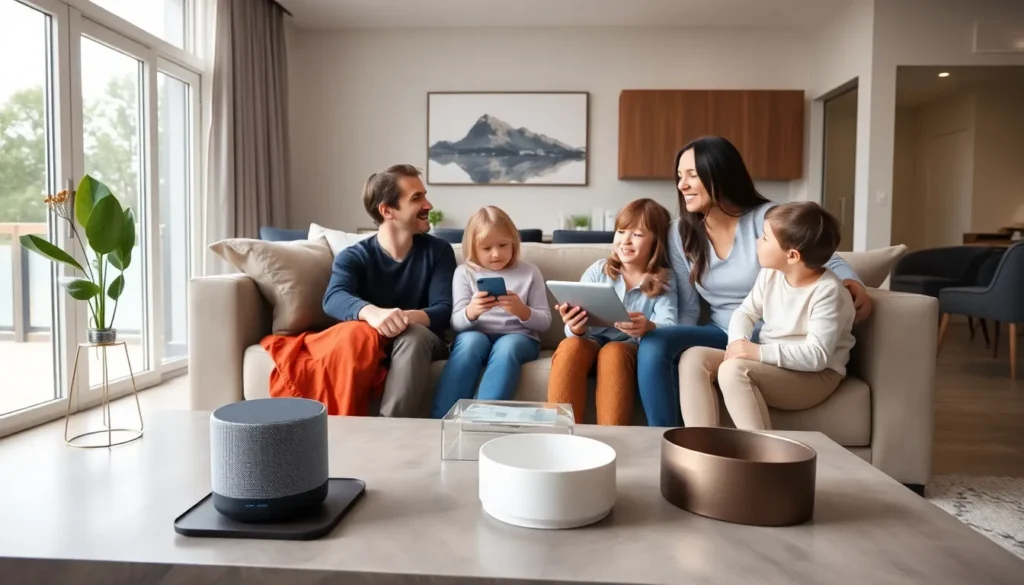Table of Contents
ToggleIn a world where technology evolves at lightning speed, digital home innovations are transforming the way people live. From smart appliances to advanced security systems, these innovations enhance convenience, efficiency, and safety in everyday life. Homeowners are increasingly embracing these cutting-edge solutions, making their living spaces more connected and responsive.
As the demand for smarter homes grows, so does the array of options available. Innovations like voice-activated assistants and energy-efficient devices not only simplify tasks but also promote sustainability. This article explores the latest trends in digital home innovations, highlighting how they can elevate the home experience and improve overall quality of life.
Overview of Digital Home Innovations
Digital home innovations transform living spaces through technology, enhancing convenience and quality of life. These advancements integrate smart appliances, security systems, and energy-efficient devices into everyday living.
Definition and Importance
Digital home innovations refer to technology-driven solutions that automate and optimize household tasks. They hold significant importance as they increase convenience, reduce energy consumption, and enhance safety. Homeowners benefit from real-time monitoring and control of their environments, leading to improved lifestyle experiences. According to the Consumer Technology Association, 60% of U.S. households utilize smart home devices, illustrating the growing significance of these innovations.
Current Trends in the Industry
Current trends in digital home innovations highlight various advancements. Key trends include:
- Smart Appliances: Devices like refrigerators and ovens connect to the internet for monitoring and remote operation.
- Voice Assistants: Virtual assistants like Amazon Alexa and Google Assistant streamline control over multiple devices through voice commands.
- Home Security Systems: Modern systems include smart cameras and sensors that offer 24/7 surveillance and alerts.
- Energy Management Solutions: Smart thermostats and energy-efficient appliances help homeowners manage energy usage effectively.
- Home Automation Hubs: Central hubs connect and control diverse smart devices, simplifying user experience.
The digital home innovations landscape continues to evolve, with technology advancements enhancing overall home functionality and lifestyle.
Smart Home Devices

Smart home devices transform how people interact with their homes. They enhance comfort and efficiency while providing greater control over various household functions.
Voice Assistants
Voice assistants like Amazon Alexa or Google Assistant serve as central hubs for smart homes. Users can control devices, access information, and manage tasks using voice commands. These assistants support an array of integrations with other devices, including lights, thermostats, and entertainment systems. With the potential to automate daily routines, voice assistants play a crucial role in modernizing home environments.
Smart Thermostats
Smart thermostats, such as Nest and Ecobee, allow for precise temperature management while promoting energy savings. Users can program schedules, monitor usage, and adjust settings remotely via smartphone apps. These devices learn user habits and adjust automatically, optimizing comfort while reducing energy consumption. Homeowners typically experience a savings of 10% to 15% on heating and cooling bills by using smart thermostats.
Security Systems
Modern security systems feature advanced technologies like motion detectors, security cameras, and smart locks. Systems from companies like Ring and Arlo provide 24/7 monitoring and real-time alerts, enhancing home security. Users can access live streams and receive notifications on mobile devices. Integration with other smart home systems enables comprehensive control. With the growing interest in home safety, many households now prioritize investing in upgraded security solutions.
Home Automation Technologies
Home automation technologies drive the evolution of digital innovations in modern households. They empower homeowners to control various aspects of their living environments, enhancing convenience, security, and efficiency.
Internet of Things (IoT) Integration
IoT integration forms the backbone of home automation, connecting devices over the internet. Smart appliances, thermostats, lighting systems, and security cameras communicate seamlessly, allowing users to monitor and control them remotely. According to Statista, the number of connected IoT devices worldwide is projected to reach 30.9 billion by 2025, highlighting the rapid growth of this technology. IoT integration also enables data collection and analysis, providing insights into energy usage and household behaviors that aid in further optimization.
Wireless and Wired Systems
Wireless and wired systems each offer unique benefits for home automation. Wireless systems, such as Wi-Fi and Zigbee, allow for easy installation and flexibility in device placement, making them ideal for retrofitting existing homes. They support a wide range of devices and can often be controlled via smartphone apps. On the other hand, wired systems, like Ethernet and powerline connections, provide stable, high-speed connectivity and are less susceptible to interference. They are typically favored in new constructions for reliability and security. Both options contribute to creating a fully integrated smart home experience that aligns with individual needs and preferences.
Digital Home Health Solutions
Digital home health solutions leverage technology to enhance healthcare accessibility and improve patient outcomes from the comfort of home. These innovations include telehealth services and health monitoring devices that cater to various medical needs.
Telehealth Services
Telehealth services offer convenient access to healthcare professionals through virtual consultations. Patients can connect with doctors, therapists, and specialists without the need to travel. This approach reduces waiting times and ensures timely medical advice. Studies have shown that telemedicine can increase patient engagement by up to 30%. A variety of platforms, such as MDLIVE and Teladoc, provide services ranging from routine check-ups to urgent care, ensuring comprehensive health support. Coverage options typically include insurance configurations and out-of-pocket payments, expanding accessibility for many individuals.
Health Monitoring Devices
Health monitoring devices provide continuous tracking of vital health metrics, empowering users to manage their health proactively. These devices include wearables like smartwatches, blood pressure monitors, and glucose meters. They collect real-time data, which is often synchronized with smartphones or tablets for easy access. Research indicates that individuals using these devices can improve adherence to health regimens, leading to better management of chronic conditions. Popular options include Fitbit for general wellness tracking and continuous glucose monitors like Dexcom for diabetes management. Many devices support alerts and notifications to inform users of abnormal readings, enhancing timely interventions.
Future Trends in Digital Home Innovations
Digital home innovations continue to advance, driven by cutting-edge technologies and evolving consumer demands. Key trends shaping the future include artificial intelligence and a strong focus on sustainability.
Artificial Intelligence Advancements
Artificial intelligence (AI) is revolutionizing the digital home landscape. AI algorithms enhance the functionality of smart home devices, providing personalized user experiences. Voice-activated assistants, such as Amazon Alexa and Google Assistant, utilize machine learning to understand speech patterns and respond more accurately to commands. Moreover, AI-driven home security systems analyze video feeds in real time, reducing false alarms and improving threat detection. With the integration of AI, devices learn user preferences, optimizing settings automatically for comfort and convenience. Projections indicate an increase in AI adoption in homes, transforming how occupants interact with their living spaces.
Sustainability and Energy Efficiency
Sustainability and energy efficiency are central to future digital home innovations. Consumers increasingly prioritize eco-friendly technologies that reduce energy consumption and lower utility bills. Smart thermostats, such as Nest and Ecobee, optimize heating and cooling efficiently, enabling energy savings of up to 15%. Additionally, solar energy systems paired with smart home technology store and manage renewable energy use, further minimizing environmental impact. Energy monitoring systems provide real-time feedback on energy usage, empowering homeowners to make informed decisions about consumption. As legislative measures and incentives promote sustainable living, the market for energy-efficient devices continues to grow, shaping a more environmentally conscious approach to digital home innovations.
Digital home innovations are reshaping the way people live and interact with their environments. As technology continues to advance, homeowners are embracing solutions that enhance convenience and safety while promoting energy efficiency. The integration of smart devices and automation technologies offers a glimpse into a future where homes are not just living spaces but intelligent ecosystems tailored to individual needs.
With the rise of AI and a focus on sustainability, the digital home landscape is poised for further transformation. These innovations not only elevate everyday experiences but also contribute to a healthier, more efficient lifestyle. As interest in smart home solutions grows, it’s clear that the future of home living is bright and filled with possibilities.







